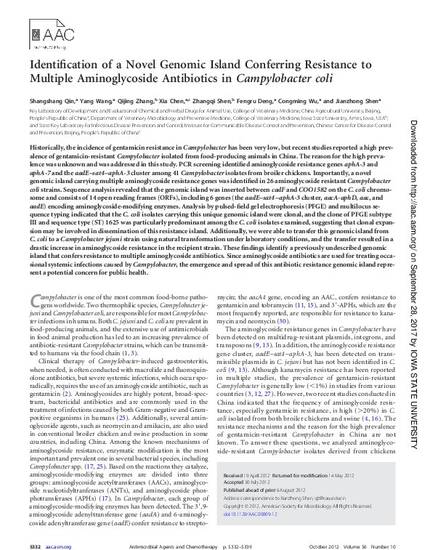
Article
Identification of a Novel Genomic Island Conferring Resistance to Multiple Aminoglycoside Antibiotics in Campylobacter coli
Antimicrobial Agents and Chemotherapy
Document Type
Article
Disciplines
Publication Version
Published Version
Publication Date
10-1-2012
DOI
10.1128/AAC.00809-12
Abstract
Historically, the incidence of gentamicin resistance in Campylobacter has been very low, but recent studies reported a high prevalence of gentamicin-resistant Campylobacter isolated from food-producing animals in China. The reason for the high prevalence was unknown and was addressed in this study. PCR screening identified aminoglycoside resistance genes aphA-3 and aphA-7 and the aadE–sat4–aphA-3 cluster among 41 Campylobacter isolates from broiler chickens. Importantly, a novel genomic island carrying multiple aminoglycoside resistance genes was identified in 26 aminoglycoside resistant Campylobacter coli strains. Sequence analysis revealed that the genomic island was inserted between cadF and COO1582 on the C. coli chromosome and consists of 14 open reading frames (ORFs), including 6 genes (the aadE–sat4–aphA-3 cluster, aacA-aphD, aac, and aadE) encoding aminoglycoside-modifying enzymes. Analysis by pulsed-field gel electrophoresis (PFGE) and multilocus sequence typing indicated that the C. coli isolates carrying this unique genomic island were clonal, and the clone of PFGE subtype III and sequence type (ST) 1625 was particularly predominant among the C. coli isolates examined, suggesting that clonal expansion may be involved in dissemination of this resistance island. Additionally, we were able to transfer this genomic island from C. coli to a Campylobacter jejuni strain using natural transformation under laboratory conditions, and the transfer resulted in a drastic increase in aminoglycoside resistance in the recipient strain. These findings identify a previously undescribed genomic island that confers resistance to multiple aminoglycoside antibiotics. Since aminoglycoside antibiotics are used for treating occasional systemic infections caused by Campylobacter, the emergence and spread of this antibiotic resistance genomic island represent a potential concern for public health.
Copyright Owner
American Society for Microbiology
Copyright Date
2012
Language
en
File Format
application/pdf
Citation Information
Shangshang Qin, Yang Wang, Qijing Zhang, Xia Chen, et al.. "Identification of a Novel Genomic Island Conferring Resistance to Multiple Aminoglycoside Antibiotics in Campylobacter coli" Antimicrobial Agents and Chemotherapy Vol. 56 Iss. 10 (2012) p. 5332 - 5339 Available at: http://works.bepress.com/qijing-zhang/45/

This article is published as Qin, Shangshang, Yang Wang, Qijing Zhang, Xia Chen, Zhangqi Shen, Fengru Deng, Congming Wu, and Jianzhong Shen. "Identification of a novel genomic island conferring resistance to multiple aminoglycoside antibiotics in Campylobacter coli." Antimicrobial agents and chemotherapy 56, no. 10 (2012): 5332-5339. doi: 10.1128/AAC.00809-12. Posted with permission.